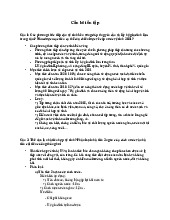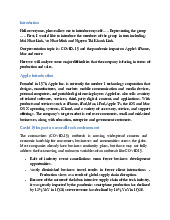







Preview text:
lOMoAR cPSD| 59054137 GRAVITY BASE FOUNDATIONS lOMoAR cPSD| 59054137 lOMoAR cPSD| 59054137
Concrete gravity base foundations able to be
floated and towed out to deeper water
windfarms and installed without specialist
marine equipment with minimum seabed preparation. CONTEXT
The UK’s major programme towards sustainable,
resilient, low carbon energy generation is pushing
forward the next stages of offshore renewables. For the
extensions to Round 2 and Round 3 in deeper waters a
new reliable approach is needed for offshore wind
turbine foundations. The Arup/Costain/Hochtief gravity
base foundation provides this. lOMoAR cPSD| 59054137 Turbine Foundation Selection
Optimum foundation selection is a function
of the variables of water depth, turbine size
and windfarm location conditions. As the
water depth and turbine size increase, the
applicability of steel monopiles becomes
limited. This limit is further constrained by
the harsher installation and operating
conditions that prevail as the windfarm
locations become progressively further
offshore. The gravity base foundation
provides an optimal solution for this
broader range of operating conditions. Gravity Base Foundations Monopile Foundations lOMoAR cPSD| 59054137 EXISTING FOUNDATION TYPES
optimising installation flexibility and facilitating
improved operation and maintenance.
The current approach to turbine foundations
typically has been steel monopiles. However, in
The Arup/Costain/Hochtief gravity base responds,
deeper waters and with larger turbines these reach
following a research and development programme, as
an upper limit which does not meet the
a self-installing turbine foundation that can be mass
requirements of the new windfarms, both in terms
produced in construction facilities located in ports to
of technical performance and offshore installation.
suit rapid deployment to the UK windfarms.
There is also a need to achieve greater flexibility
through the supply chain that can increase the
Concrete gravity bases can be successfully
market’s capacity and avoid dependency on large
deployed at all upcoming windfarms around the UK scale steel tubulars.
coast. For example, 84% of the Round 3 sites are
in water depths over 30m, where concrete
foundations may prove the best solution. Our
gravity base foundation combines this with self-
installation to avoid the need for specialist and expensive marine equipment. < GRAVITY BASE FOUNDATION CONCRETE GRAVITY BASES
Offshore windfarms are capital intensive projects
and turbine foundations represent a quarter of
their total delivery cost. The renewable industry
is looking for creative yet dependable new
approaches to drive down this cost, whilst lOMoAR cPSD| 59054137
< Sweden’s largest offshore wind
energy farm, Lillgrund, required 49 large concrete foundations weighing around 1,400 tonnes each. These were constructed at a facility in Poland and transported by sea to their
required location. The concrete foundations were placed very
precisely onto their stone bases located in water up to 11 metres. KEY FEATURES & BENEFITS
• Construction can be sited at ports well placed
to suit windfarm locations, with discussions Foundation Design ongoing with selected ports
• Reinforced concrete, non-piled, ballasted
• Concrete costs are less dependent on gravity structure
commodities with high price volatility, such as
• Caters for water depths up to 60m steel
• Suits larger turbine sizes up to an anticipated
• Concrete gravity base foundations do not use 8MW
large scale steel tubulars, therefore they will
increase the market’s capacity to deliver
• The design minimises the need for seabed
preparation by accommodating existing
turbine foundations, release supply chain
seabed slopes and surface sediments
constraints and increase competition
• Construction can draw on existing resource
• The design incorporates skirt variants to suit seabed soil conditions
pools close to the construction facilities
• Existing supply chain capabilities can be
• Designs can be standardised across
< Safe working practices are
implemented throughout projects
from design to construction and installation.
> Building on existing experience of
successfully installing a 600m long
breakwater in the Pacific Ocean that was made out of 12 slipformed 25,000t caisson
structures fabricated in a purpose
individual or multiple sites to enable cost
leveraged to enable projects to start optimisation immediately
• Collar design for the turbine mast connection
• A dedicated mass construction facility will
can accommodate ~2o vertical alignment
deliver productivity benefits and reduce costs tolerance
• Health and safety considerations will be
• Offers life cycle carbon footprint benefits
integral to the development of the new through material selection
construction facilities and foundations
constructed in them, using well proven safe
• Unlike many alternatives, the design offers the
potential to repower without foundation construction expertise
replacement Construction / Fabrication
• The concrete bases are configured for rapid
construction using readily available construction skills
• Construction is an onshore activity and
tailored for ease of subsequent installation
• Construction does not require deep water (10m draft) built dry dock. lOMoAR cPSD| 59054137 Installation Concrete volume 1,910m3
• Foundations are self-buoyant for ease of
deployment to the windfarm location Steel reinforcement 720 tonne
• Standard tugs that are readily available and Partnership
abundant are used to install the foundations
The gravity base foundation is a development by a
• Sea-borne noise and vibration is minimised so
partnership between Hochtief, Costain and Arup,
installation can progress year-round
founded on long term relationships from previous
projects and combines unique capabilities to serve
• Reduced weather dependency
significantly extends the installation season
the growing energy sector. Hochtief’s strong giving security of programme
marine competence, Costain’s civil engineering
and marine construction experience and Arup’s
• Installation wil be achieved by sinking through
offshore marine and concrete structure design
the controlled influx of water, followed by
expertise are the ideal basis to offer a unique and sand/aggregate ballasting
differentiated solution that ful y integrates the
design, construction, offshore installation and Operation
decommissioning of foundations for offshore
• Concrete has low maintenance requirements windfarms.
being inherently durable in the marine environment
• Scour protection wil be designed for minimum
maintenance over the design life of the windfarm
• The durability of the concrete gravity
foundations could allow developers to re-deploy
them in different locations with new turbines fitted
• Concrete gravity bases can be completely
removed for recycling at the end of their useful life Principal Data
Key figures for 35m water depth, Central North
Sea environmental conditions and 6MW can be found below: Air gap concrete structure 20m Hub height above LAT 90m Base outer diameter 34m Outer diameter, caisson 31m Outer diameter, top of shaft 6m lOMoAR cPSD| 59054137 Contacts: Gordon Jackson Colin Duff Fenno Leeuwerke T +44 207 755 2289 T +44 1628 842444 T +49 40 21 986350
E gordon.jackson@arup.com E colin.duff@costain.com E fenno.leeuwerke@hochtief.de
For further information contact: (Back: Contact Title) Name (Back: Contact Name)
T xxxxxxxxxxxxxxxxxxx (Back: Numbers) E
xxxxxxxxxxxxxxxxxxxx ( Back: Numbers) www.arup.com


